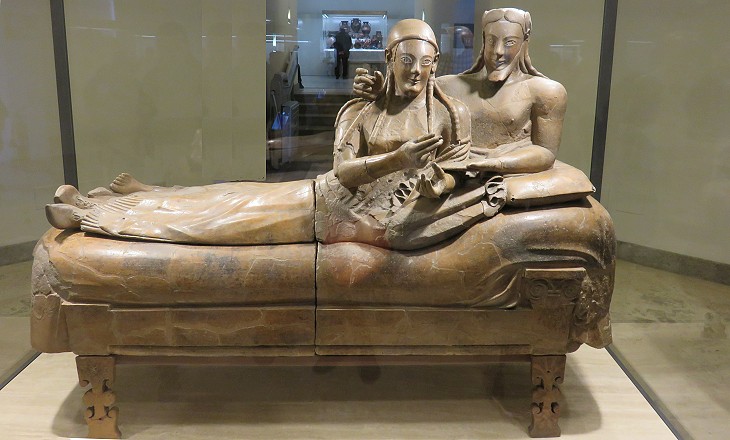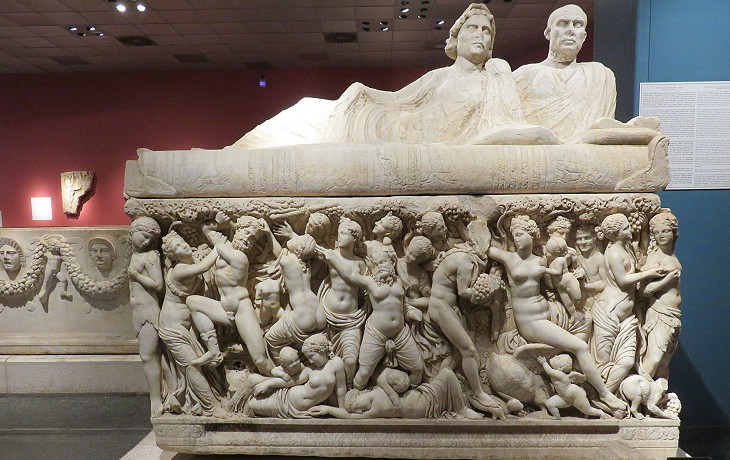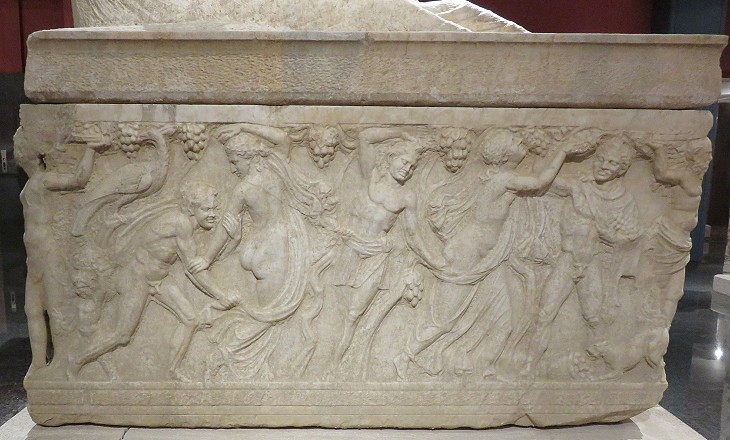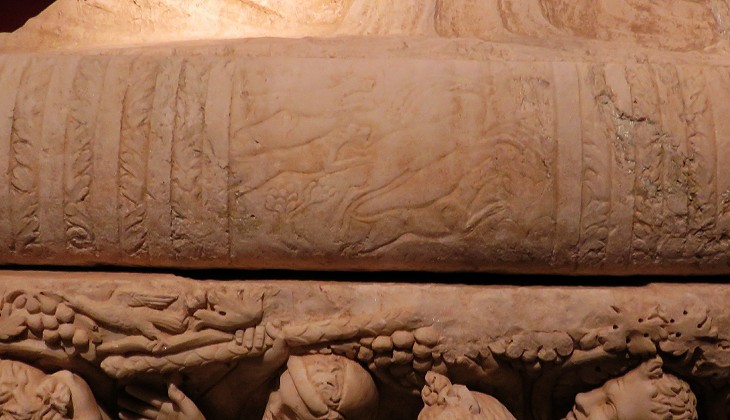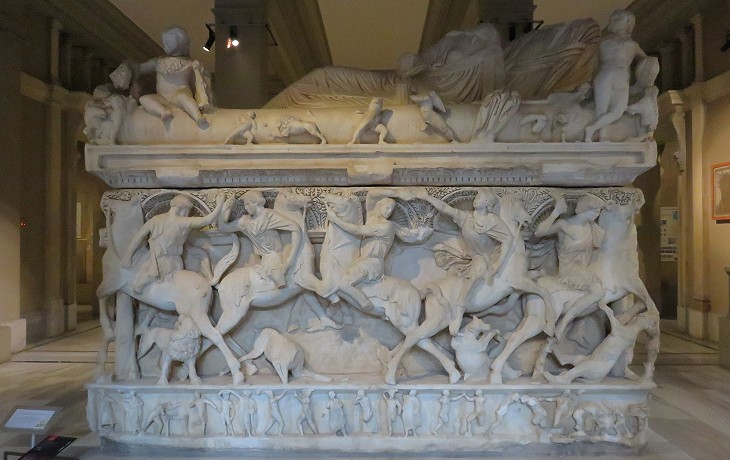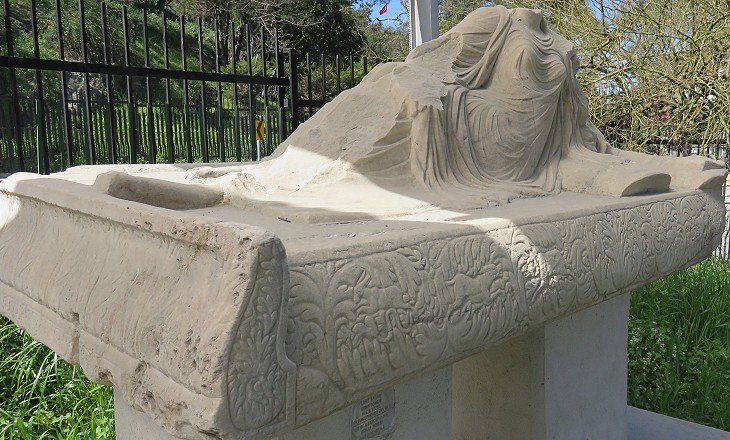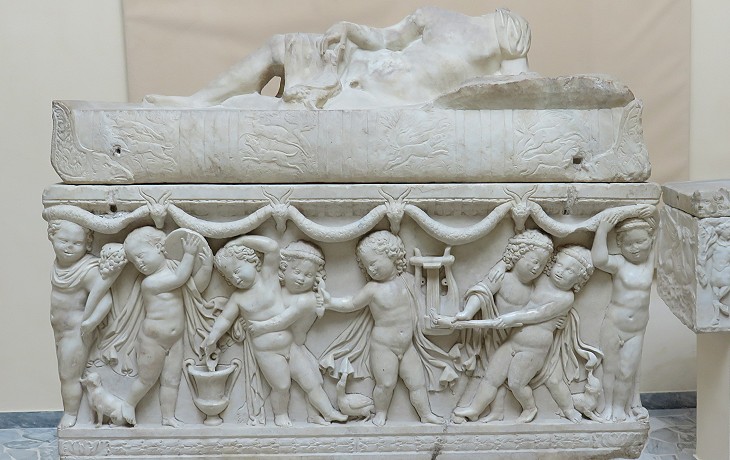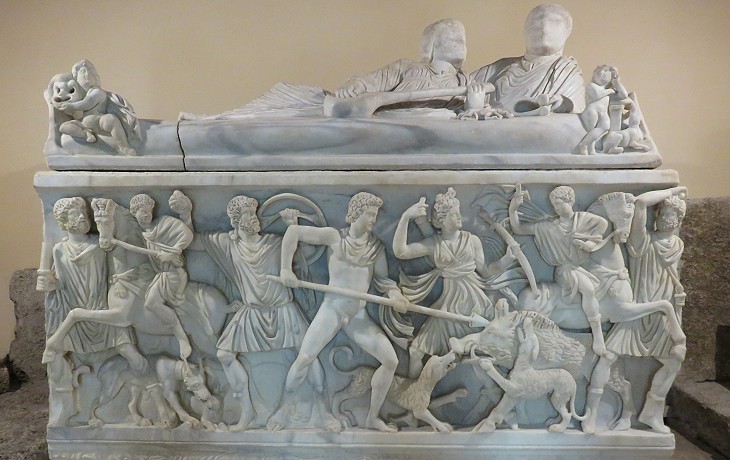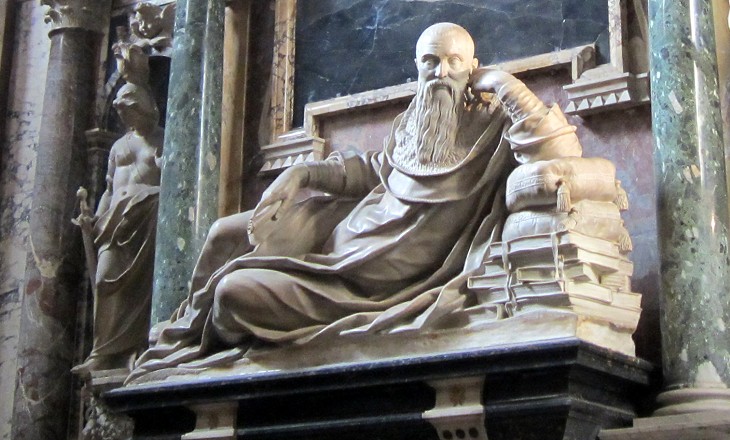  What's New! Detailed Sitemap All images © by Roberto Piperno, owner of the domain. Write to romapip@quipo.it. Text edited by Rosamie Moore. Page added in July 2015. | 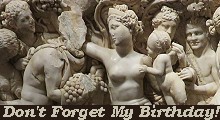 - Roman Funerary Rites - Roman Funerary Rites
(detail of a sarcophagus from Perge)
Then put off every man his armour, they took the horses from their chariots, and seated themselves in great multitude (..) (and they) feasted with an abundant funeral banquet. Many a goodly ox, with many a sheep and bleating goat did they butcher and cut up; many a tusked boar moreover, fat and well-fed, did they singe and set to roast in the flames of Vulcan; and rivulets of blood flowed all round the place where the body (of Patroclus) was lying. Omer - The Iliad - Book XXIII - Translation by Samuel Butler In most ancient civilizations a banquet was a key element of funerary rites and it was depicted in many gravestones, vases and paintings. The Sarcophagus of the Spouses portrays a couple attending a funerary banquet. It did not contain the bodies of the dead, but their cinerary urns. It shows that in Etruscan society women had a more important role than in the Greek one which did not allow them to attend such banquets. There is no sign of grief in the slightly smiling faces of the couple; they seem to welcome their guests to a festive party. They held something in their hands, perhaps a fruit, or an egg or a flask with perfume. Although similar sarcophagi were used by the Etruscans for many centuries (see a page on Tuscania) they were not popular among the Romans, whose family tombs were expected to house a very large number of cinerary urns in a small space (e.g. Sepolcro degli Scipioni).
During the IInd century AD the practice of inhumation gained ground versus that of cremation owing to a general move of society towards beliefs which implied some forms of resurrection. Stone sarcophagi had been widely used in many regions of Asia Minor along the Aegean Sea from Assos in the north to Xanthos in the south. In the IInd century AD this practice spread to many parts of the Roman Empire. Building upon the availability of fine-grained white marble at Docimeium, near today's Afyonkarahisar, many workshops in Asia Minor began to make elaborately decorated sarcophagi for wealthy customers. The workshops had different "production lines", one of which, similar to the Sarcophagus of the Spouses, portrayed the dead attending a banquet on the lid.
The sarcophagus found at Perge shows the high level of skill (and talent) available in the workshop where it was made. The execution of the complex Dionysiac scene is excellent both in the front, where a high relief technique was used (with figures projecting or entirely detached from the background), and in the back, where low relief was used. The use of different relief levels is due to the fact that in Asia Minor sarcophagi were placed at the centre of the room, so they had to be decorated on all sides, whereas in Rome they were placed against a wall and a projecting decoration of the rear side would have been an obstacle to their positioning. This sarcophagus was not made to order and its lid left the workshop in half-finished condition. The portraits of the dead were completed at a later time, after they had reached their final destination, by local skilled workmen.
Stiacciato (It. schiacciato, pressed) is the name given to a very low relief used in the XVth century by Donatello and other Renaissance sculptors including Giovanni Dalmata. In this sarcophagus stiacciato was used for the embroidered cushion of the couch to depict hunting scenes. The complex decoration of the sarcophagus did not include references to death.
The Management of the Museum classifies this sarcophagus as a Sidamara one, after the location near Konya where sarcophagi with figures framed by niches were found. In the front side of the sarcophagus however the orderly frame provided by the niches is hardly noticeable and the decoration is an explosion of life which invades the lid.
The decoration of the rear side is more composed with the niches being given more prominence. They were made with yet another technique: it was based on the use of a drill to obtain a series of holes which depicted their architectural elements. The use of drills became very common in Byzantine art, especially for making very elaborate capitals (e.g. at Sts. Sergius and Bacchus at Constantinople).
The box of this sarcophagus is lost, but based on the lid, we may assume it had a very carefully designed decoration. Lavoro di bottega (workshop work) is a term often used by Italian art historians to indicate a statue or a painting by an unidentified artist which do not have peculiar features. When instead the work of art departs from routine its unidentified author is named after it e.g. Maestro del Duomo di Orvieto indicates the author of some of the reliefs which decorate the doors of Orvieto Cathedral.
A similar approach ought to be followed for these sarcophagi and other works of art of the Hellenistic and Roman periods. The focus on the art of Classical Greece (Vth century BC) which began in the XVIIIth century has dubbed as decadent the works of art made after that period. This view has been helped by the fact that sculptors did not hold a high position in the Hellenistic/Roman societies and we know the names of a handful of them. Art historians ought to deepen their studies into these works of art and not just label them by the period they were made and the location where they were found. The scenes depicted on this lid deserve it.
This sarcophagus shows such a similarity with that of Perge that it is likely it was made in the same workshop and then sent to a dealer at Ostia who sold it to the final customer. It has small holes in the box and in the lid (holes missing in the sarcophagi of Asia Minor). The holes were made by unskilled hands and they were used for profusiones, pouring in of wine or milk or pieces of cakes in honour of the dead. This practice of piety was eventually reprimanded by Saint Ambrose in the late IVth century: When my mother had once, as she was wont in Africa, brought to the Churches built in memory of the Saints, certain cakes, and bread and wine, she was forbidden by the door-keeper: so soon as she knew that the Bishop (St. Ambrose) had forbidden this, she so piously and obediently embraced his wishes. St. Augustine - The Confessions - Book VI - 2 - Translation by Edward Bouverie Pusey.
In the side decoration is interesting to note: a) the sculptor designed a motif based on studs for the two wooden supports between which the cushion was placed; b) the children are in a joyful mood, but one of them, in a rather nonchalant manner, holds down a torch, a symbol of death (but perhaps a reference to Ovid's words: While these funerary rites are enacted, girls, don't marry. Let the marriage torches wait for purer days). Ovid made reference to Feralia, a public holiday on February 21st which celebrated the souls of the dead. In addition to this general commemoration, funerary rites including profusiones were performed on the birthday of the dead and not on the anniversary of their death. Most tombs of the rich had a small hall where these ceremonies were performed. It was placed above the underground room where sarcophagi and cinerary urns were kept (as it can be seen in many of the brickwork tombs along Via Appia Antica).
How sharper than a serpent's tooth it is / To have a thankless child! William Shakespeare - King Lear - Act I Usually the wealthy Romans who could afford an expensive marble sarcophagus left enough money in their will for the performance of periodical funerary rites. Something must have gone wrong at Vicovaro. Not only this sarcophagus does not have the holes for profusiones, but the heirs did not care to hire a local sculptor to actually portray the dead out of the roughly designed heads made at the workshop.
The Christian prohibition of the ancient funerary rites meant that this type of sarcophagi went out of production. During the Renaissance however some of these sarcophagi were found and they had an influence on Nicolas Cordier and Pope Clement VIII, his patron: the father of the pope was portrayed in a pose similar to that in the ancient sarcophagi. Another attempt of using this pattern was made by Ercole Ferrata at Cappella Spada in S. Girolamo della Carità, but eventually other types of funerary monuments were developed by Gian Lorenzo Bernini which were more in line with the doctrine of the Roman Church (see a page on Baroque Sculpture). You may wish to see these other pages (for a full list see my detailed index).   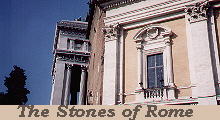 |
